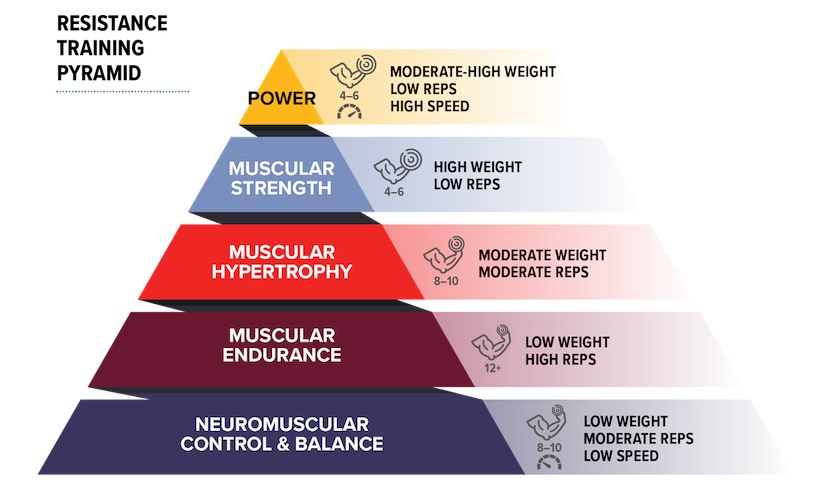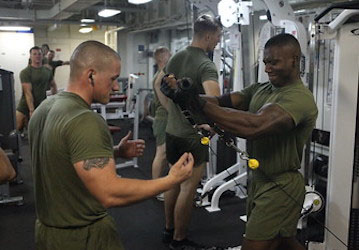Planning your workouts can be challenging if you’re new to working out on your own. Here are some basics to get started.
 Understand the resistance training pyramid
Understand the resistance training pyramid
The resistance training pyramid describes a general progression to follow when planning your workouts over a period of weeks or months. It keeps you from focusing too much on one area and helps give variety to your workout to keep you engaged. Following the pyramid design uses a type of workout programming called linear periodization. It’s somewhat similar to block periodization where you have periods of time dedicated to working on specific components of fitness. But rather than having a specific component of fitness that you’re training to improve (like you do in a block-periodized program), you’ll have a gradual change in volume and intensity over time. Linear periodization is a smoother transition between levels of the pyramid over time.
Neuromuscular control and balance
At the base of the pyramid is neuromuscular control and balance, also known as stabilization. This section of the pyramid is what will be most helpful for injury prevention. A stabilization workout focuses on performing low-weight exercises correctly. You do them slow and controlled to improve how well you move during the exercise. Beginners should spend 2–3 weeks focusing on stabilization exercises to improve neuromuscular control and balance, and to familiarize yourself on how to do the lifts with weights. After those 2–3 weeks, you can continue to incorporate stabilization exercises as a dynamic warm-up before your workout, and some other exercises as part of a core workout. Unlike the other levels of the pyramid, this “base level” should be incorporated in all workouts as time goes on.
Muscular endurance
The next level up the pyramid is muscular endurance. Beginners should focus on endurance before the other components of the pyramid because you’ll use lower weights. This allows you to get even better at the lifts so you can perform them safely with higher weights. About 4–6 weeks is a good amount of time to spend working on muscular endurance so you can see improvements. After the first 2–3 weeks you spent on stabilization, your progress can seem to slow down—and that’s normal because it’s how your body starts to adapt to the resistance training you’ve been doing.
Muscular hypertrophy
Muscular hypertrophy, or building muscle mass, is the middle level of the pyramid. When you look at the ranges of volume and intensity for muscular endurance, hypertrophy, and strength, hypertrophy is the middle ground. You’ll use moderate loads (67–85% of your 1RM) for moderate reps (6–12). Since muscle strength is associated with muscle size, it makes sense to train to increase hypertrophy before maximal strength training. It generally takes 4–6 weeks to start to see muscle growth, and closer to 8 weeks to really get visibly noticeable results.
Some people might be concerned that they’ll “get too big” and have goals of being physically strong, but not enormously muscular. There a few important things to note here: 1) If you’re new to resistance training, you’ll start to put on muscle mass. That will happen even if you aren’t specifically training for muscular hypertrophy. 2) As you build muscle mass, you’ll start to lose body fat. Muscles are hungry and will burn more calories to maintain their size. For men, this often means losing a bit off the beer gut. For women, it means you might start to look more muscular. That has to do with where men and women carry most of their body fat. Men tend to carry it viscerally, meaning attached to muscles and internal organs—so that’s why overweight men are more “apple shaped.” Women tend to carry their body fat subcutaneously, meaning under their skin and over their muscles. As women lose body fat, it starts to expose the muscles underneath the fat, giving that muscular appearance. It isn’t so much that you’re “getting huge”—you’re just able to see your muscles better.
Some people might want to skip the hypertrophy level of the pyramid. That’s OK. You can still get stronger without dedicating a period of time to increasing muscle size. Just know that you’ll still increase your muscle size when strength training, but it won’t be as efficient as if you dedicated a training period to it.
Muscular strength
After hypertrophy comes muscular strength. As you’ve been progressing to this point, the amount of weight you lift for each level has slowly gone up, and the number of repetitions has gone down. Again, you’ll want to spend 4–6 weeks working to specifically improve muscular strength, gradually increasing weight and decreasing reps, until you’re only doing 4–6 per set.
Muscular power
The final, top-most level of the resistance training pyramid is developing power, or the ability to move objects quickly. You don’t always need to get this far up the pyramid, especially if you have a less physically demanding job. Even if you don’t need to have power, these types of lifting are the most fun for some people because you’re usually lifting weights overhead and doing explosive movements. The weight you use can range from moderate to heavy, and you generally will perform the movements quickly so your muscles have a new stimulus to adapt to. A power phase is almost always done after building strength because higher levels of muscular strength are very important to generating power.
 Choosing the right personal trainer Read More
Choosing the right personal trainer Read More
As you plan your long-term workouts, you don’t need to choose specific exercises for the phase that’s several months out. But following the pyramid structure gives you some guidance about how to progress over time, as opposed to just week-to-week. If you’re just beginning a resistance training program, use the early two phases to experiment a bit. Find specific exercises that you like and don’t like, and take the time to get good at them. Then by the time you need to start really adding on the weight, you are an expert in those lifts and can do them safely.
